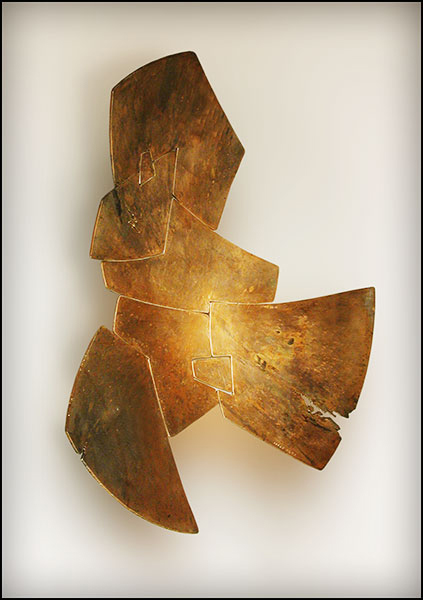Artist Statement: My early work in design had the goal of “perfection” – classic geometry, perfect joinery, perfect finishes. Over a period of several years I struggled with whether this was true to life. It certainly wasn’t true to my life or the life of many folks around me. I wondered how to show pain & the struggle of process in my work, but it took several years before I could relax into an organic expression of this. Possibly I was taking a cue from the Japanese wabi sabi aesthetic when I finally began to break up my perfect shapes, began to introduce cracks, and patinas that actually let time and decay have their way with my ‘perfection fantasy.’ To this day, nearly all my favorite work has some essential element of sorrow, pain, or the relentless process of time and weather. My sense of beauty in both the visual arts and music nearly always has these elements somehow: the minor key visualized as rust, decay, cracks, broken things reassembled – I love them all as a more honest & tender reflection on actual life. Lent is my favorite sacred time. I look forward to a time of reflection on the darker, the more honest, the hope of change mixed with an honest sense of difficulties and failures. Perhaps the deepest beauty always has some element of suffering, of the bittersweet, of a great longing.
Bio: American sculptor working in several genres - residential furniture, public sculpture, alternative liturgical, and funerary objects. Works broadly with functional, sculptural, and ceremonial objectives. Orth works primarily in wood, steel, and bronze. Since 1980.
Orth spent his first nine years in Texas, but then moved with his expatriate family to Costa Rica & Guatemala during the 1960s. In all these places he was drawn to informal mentoring situations under local craftsmen working with highly inventive, but primitive methods. (It was not unusual for a Guatemalan cabinetmaker to accomplish an impressive amount of detailed work with only a dozen handmade tools - none of them electric.) In his 20s he lived and worked briefly in Amsterdam. He has lived and worked in the Chicago area since then.
Orth's work shows contrasts between mainstream 20th Century design and sensitivities drawn from archeology & world art. True to his own personal conflicts, Orth’s work exhibits both Gothic drama and the happy play of Mid-Century Modern – often within the same pieces. Orth’s early projects were highly polished, residential furniture in a range of Arts & Crafts, Prairie School, & Modern styles. However, for the bulk of his career postmodern issues have been a priority – producing work featuring weathered & deconstructed surfaces, fine art patinas on wood and metal – and a wide range of functionality (or lack of it) including public sculpture and alternative liturgical and funerary objects. As far as design movements go, Orth feels most engaged with the Western movements of De Stijl, Postminimalism, and Deconstruction. The Non-Western aesthetics of Japan are also a major influence.
Orth's sculpture & furniture have been featured in museums and galleries since the mid-1980's. He has taught sculpture, interior architecture, and designed objects at The School of the Art Institute of Chicago. He is a member of the Chicago Furniture Designers' Association and served on its board of directors for five years. He teaches at Marc Adams School of Woodworking and gives occasional presentations at local guilds & clubs. Orth leads trips to Japan with a focus on crafts, architecture, & landscaping.
While two degrees in philosophy are an unusual background for this line of work, the habit of constant questioning & restructuring enters David's work at multiple levels. The broad idea that serious craft might be a way of seeing and engaging the world took hold of him during graduate work in philosophy and returned his attention to working with his hands. In his own words, art offers “highly-electrified connections between ordinary life, human longing, and the insane immensity of the universe. Philosophy takes entirely too long getting around to that”. He describes the situation in words pilfered from T. S. Eliot. “Every [pencil line] is a step to the block, to the fire, down the sea's throat, or to an illegible stone: and that is where we start."
The resulting furniture, sculpture, & ceremonial objects are broadly appealing, critically acclaimed, and unexpected. James A. Mangum, author of the Dos Cruces Trilogy has called Orth’s work “Amazing, overwhelming, musical. Rock and roll, the blues, arias.” Designer Sandy Hill says the work has “wonderful, mess-with-your-mind appeal.”
|






